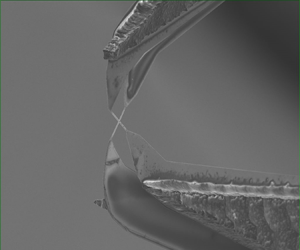Article contents
Examining the inertial subrange with nanoscale cross-wire measurements of turbulent pipe flow at high Reynolds number near the centreline
Published online by Cambridge University Press: 26 May 2021
Abstract

Highly resolved, two-component velocity measurements were made near the centreline of turbulent pipe flow for Reynolds numbers in the range  $102 \le Re_\lambda \leq 411$ (
$102 \le Re_\lambda \leq 411$ ( $1800 \le Re_\tau \leq 24\,700$). These unique data were obtained with a nanoscale cross-wire probe and used to examine the inertial subrange scaling of the longitudinal and transverse velocity components. Classical dissipation rate estimates were made using both the integration of one-dimensional dissipation spectra for each velocity component and the third-order moment of the longitudinal structure function. Although the second-order moments and one-dimensional spectra for each component showed behaviour consistent with local isotropy, clear inertial range similarity and behaviour were not exhibited in the third-order structure functions at these Reynolds numbers. When corrected for the effects of radial inhomogeneities at the centreline following the generalized expression of Danaila et al. (J. Fluid Mech., vol. 430, 2001, pp. 87–109), re-derived for the pipe flow domain, the third-order moments of the longitudinal structure function exhibited a clearer plateau per the classical Kolmogorov ‘four-fifths law’. Similar corrections described by Danaila et al. (J. Fluid Mech., vol. 430, 2001, pp. 87–109) applied to the analogous equation for the mixed structure functions (i.e. the ‘four-thirds law’) also yielded improvement over all ranges of scale, improving with increasing Reynolds number. The rate at which the ‘four-fifths’ law and ‘four-thirds’ law were approached by the third-order structure functions was found to be more gradual than decaying isotropic turbulence for the same Reynolds numbers.
$1800 \le Re_\tau \leq 24\,700$). These unique data were obtained with a nanoscale cross-wire probe and used to examine the inertial subrange scaling of the longitudinal and transverse velocity components. Classical dissipation rate estimates were made using both the integration of one-dimensional dissipation spectra for each velocity component and the third-order moment of the longitudinal structure function. Although the second-order moments and one-dimensional spectra for each component showed behaviour consistent with local isotropy, clear inertial range similarity and behaviour were not exhibited in the third-order structure functions at these Reynolds numbers. When corrected for the effects of radial inhomogeneities at the centreline following the generalized expression of Danaila et al. (J. Fluid Mech., vol. 430, 2001, pp. 87–109), re-derived for the pipe flow domain, the third-order moments of the longitudinal structure function exhibited a clearer plateau per the classical Kolmogorov ‘four-fifths law’. Similar corrections described by Danaila et al. (J. Fluid Mech., vol. 430, 2001, pp. 87–109) applied to the analogous equation for the mixed structure functions (i.e. the ‘four-thirds law’) also yielded improvement over all ranges of scale, improving with increasing Reynolds number. The rate at which the ‘four-fifths’ law and ‘four-thirds’ law were approached by the third-order structure functions was found to be more gradual than decaying isotropic turbulence for the same Reynolds numbers.
JFM classification
- Type
- JFM Papers
- Information
- Copyright
- © The Author(s), 2021. Published by Cambridge University Press
References
REFERENCES
- 2
- Cited by



